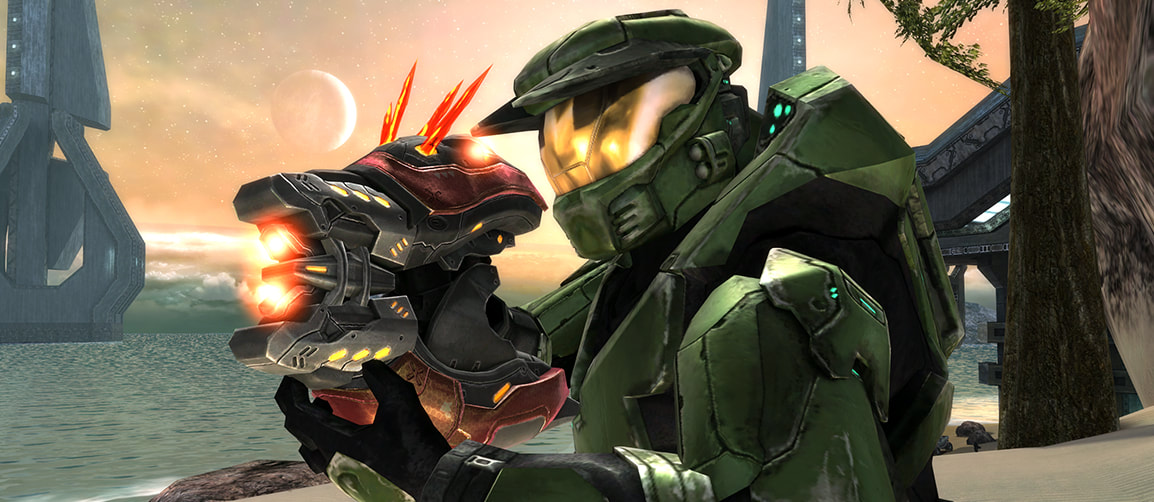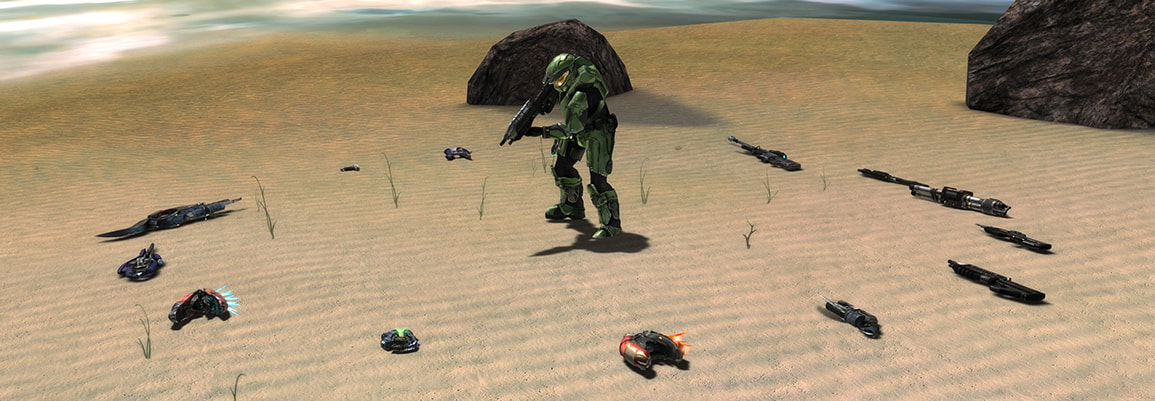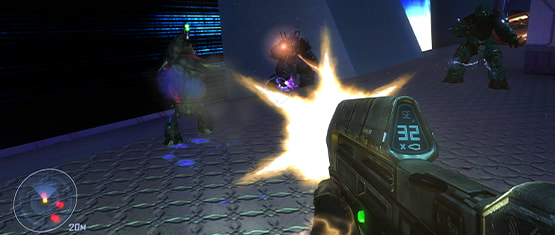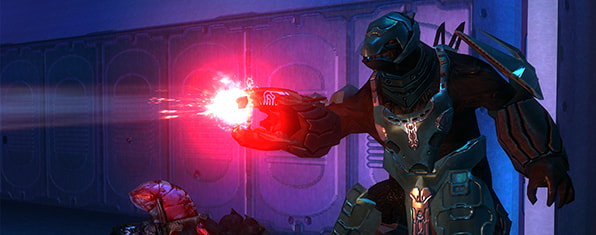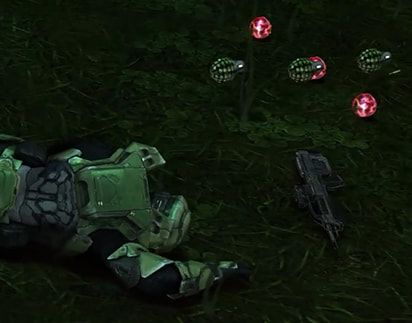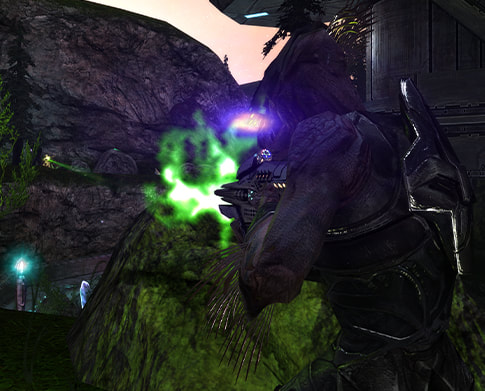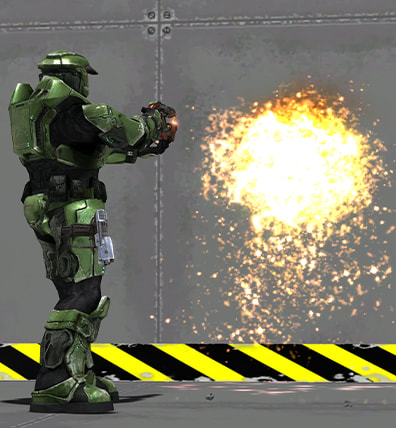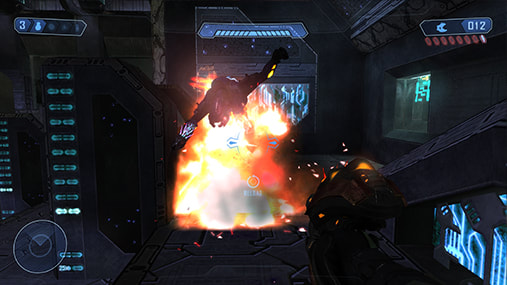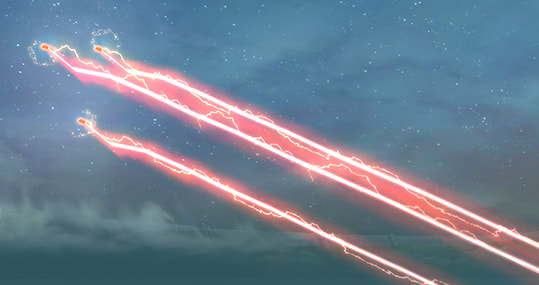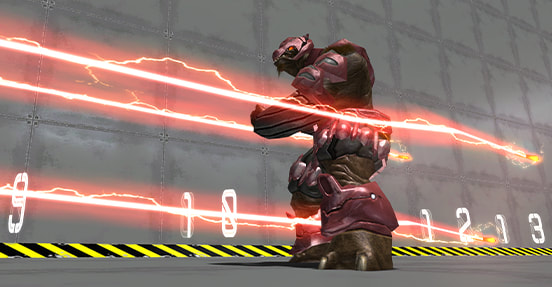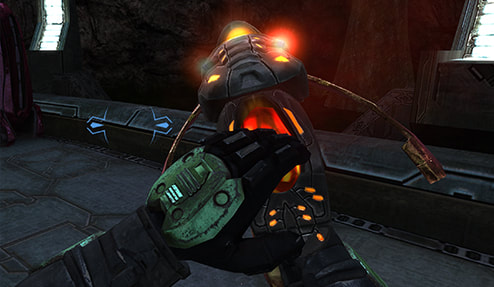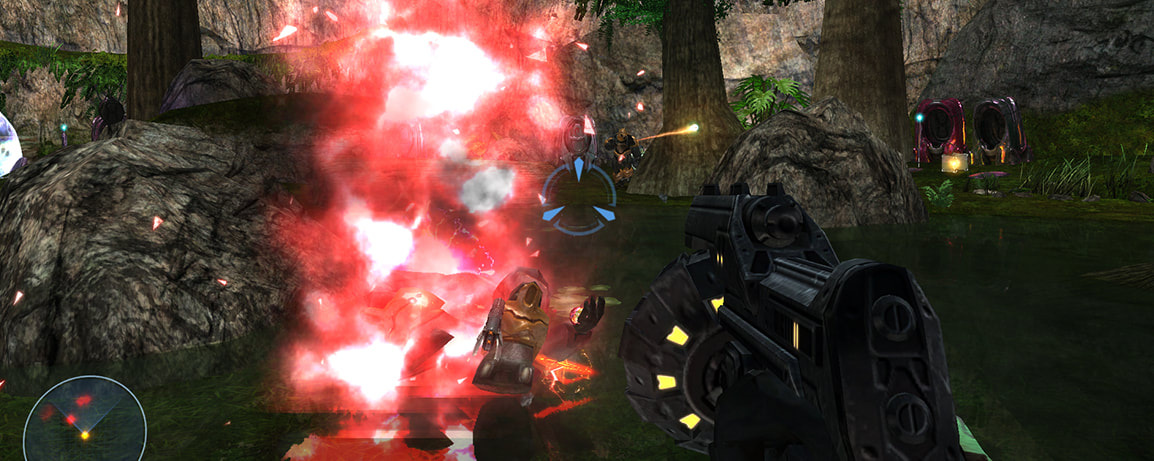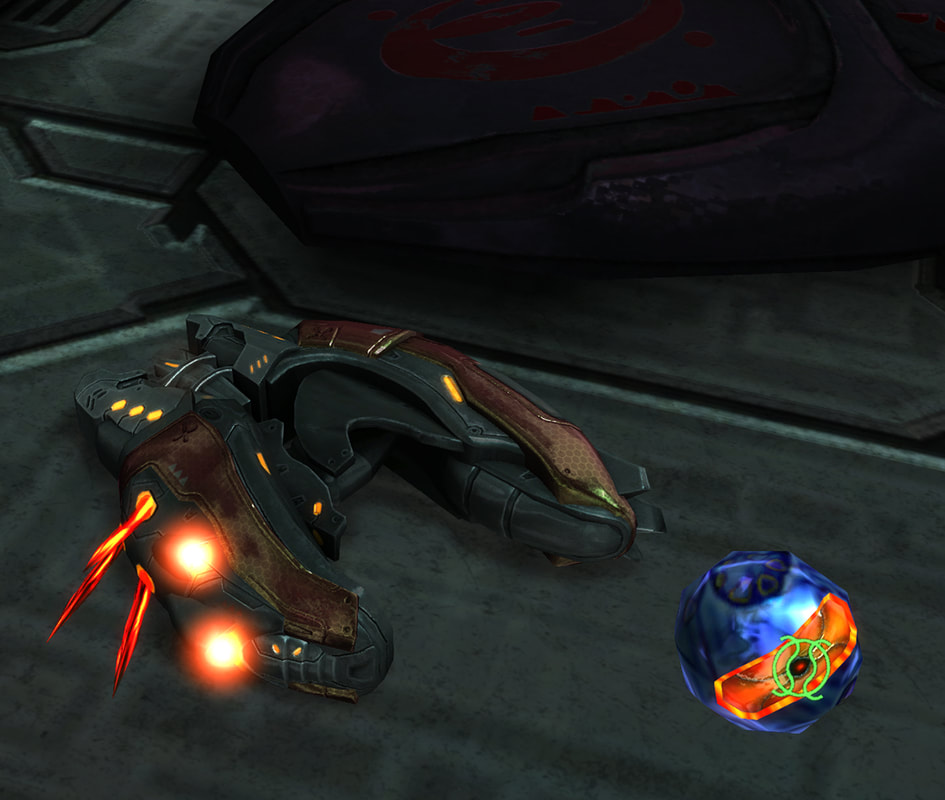Making the Shredder
|
by Ifafudafi (2022)
|
…was really just making a mod that needed a Shredder
I’ve been asked multiple times how and why we created the Shredder, our most popular weapon. Here’s the answer: we created the Shredder because TSC:E's design goals required it. That’s it!
Really! That's it! I mean, that's not really it, or I wouldn't have an article to write. What I'm saying is that TSC:E benefitted from extremely clear direction, meaning we didn't have to invent a gun out of thin air. Instead, we had a well-defined, empirically-based design framework, backed by plainly-articulable beliefs. This framework said we needed a gun with certain characteristics, and none of our existing Halo weapons fit the bill. All I did was fill that hole.
Every Halo mod I'd made or seen lacked this clear direction. Instead, I heard – and continue to hear – stuff like:
Without clear direction, you end up having to guess. "I guess we should have a Battle Rifle." "I guess we should add this mechanic." "I guess I need to nerf that weapon." And guesses, unfortunately, are often wrong.
Really! That's it! I mean, that's not really it, or I wouldn't have an article to write. What I'm saying is that TSC:E benefitted from extremely clear direction, meaning we didn't have to invent a gun out of thin air. Instead, we had a well-defined, empirically-based design framework, backed by plainly-articulable beliefs. This framework said we needed a gun with certain characteristics, and none of our existing Halo weapons fit the bill. All I did was fill that hole.
Every Halo mod I'd made or seen lacked this clear direction. Instead, I heard – and continue to hear – stuff like:
- "I want it to be fun!" There are lots of ways to be fun, many of them mutually exclusive. Something that's fun for you, or some subset of the audience, will be miserable to another. Which approach do you pick? If you had clear direction, you'd already know. Fun isn't direction, it's what happens when your direction works.
- “I want people to like it!" There are many easier ways to get your brain to inject that sweet social validation dopamine than creating a Halo mod of any significant substance. This isn't direction, it's abdicating direction to the audience. If you really wanted this, you’d be a simple proxy for every single possible player's contradictory requests, unable to ever say "no."
- "I want it to be like Halo _!" Well, is it Halo _ or is it not? Either you're creating an exact replica of the game, level-by-level, in which case any of your own direction is counter to this goal; or, more likely, you're attempting some synthesis of the game you're modding and Halo _. That's fine, but it's not direction. What do you keep? What do you discard? Why? Any divergence is not "like Halo _", it's something new, that you haven't yet defined.
Without clear direction, you end up having to guess. "I guess we should have a Battle Rifle." "I guess we should add this mechanic." "I guess I need to nerf that weapon." And guesses, unfortunately, are often wrong.
Once we'd nailed down TSC:E's direction – which, to be clear, was a long and painful process that started a lot of fights – we no longer had to guess. Whenever there was a decision to make, we already knew what to do. Half of this was "creative," in that we knew exactly how the map should feel, and what kinds of behavior we did and didn't want to see from players. The other half was hard math, providing absolute guarantees that our feeble brains are incapable of accurately estimating on their own. Both were necessary for success.
As with most things, we found that out the hard way.
As with most things, we found that out the hard way.
The roots of this go back to my work on CMT's 2012 Truth & Reconciliation demo. I'd planned to leave Halo modding before then, but I was asked by Masterz to be CMT's effects artist, and hadn't yet understood what a dysfunctional minefield I'd be walking into. Once I agreed to join, it quickly came to light that its initial SPv2-derived gameplay was a total disaster, and pretty much everybody knew it.
Unfortunately, despite multiple team members repeatedly asserting that the mod was no fun to play, he remained unconvinced of his fallibility. Undeterred, I took a step that, as far as I know, no Halo mod had ever before seen: I actually sat down and spent a few days transcribing every weapon and unit's damage and vitality values into a big ass spreadsheet. With this, I could see how each weapon actually was behaving. I had DPS, kill times against each rank on all difficulties, potential kills per magazine, and more. I no longer had to guess.
The results were clarifying, in that they revealed multiple blatant errors, and outright contradictions of stated intent. The SMG, for example, pitched to me as being stronger than most guns, was in fact significantly weaker. Unit-specific modifiers were all over the place – a weapon that could shred Grunts would suddenly be useless against Jackals. My spreadsheet included Halo 1's stats as reference, and the contrast made it clear: Bungie had concrete math backing their gameplay. The proto-SPv3 weapons had nothing of the sort, and it was no wonder that they felt like a broken mess.
Soon, for this and many other reasons, Teh Lag assumed leadership of the team, and I was now in charge of the gameplay. I immediately got to work putting the math in order. A few rules emerged. Here are some of the more interesting ones:
Our new formal playtesting initiative confirmed everything I'd hoped for: we received consistent feedback that the mod was much more coherent and enjoyable to play. We received consistent feedback that this was the first time a CMT product felt like a polished game, and not like a slapdash collection of discordant ideas.
The results were clarifying, in that they revealed multiple blatant errors, and outright contradictions of stated intent. The SMG, for example, pitched to me as being stronger than most guns, was in fact significantly weaker. Unit-specific modifiers were all over the place – a weapon that could shred Grunts would suddenly be useless against Jackals. My spreadsheet included Halo 1's stats as reference, and the contrast made it clear: Bungie had concrete math backing their gameplay. The proto-SPv3 weapons had nothing of the sort, and it was no wonder that they felt like a broken mess.
Soon, for this and many other reasons, Teh Lag assumed leadership of the team, and I was now in charge of the gameplay. I immediately got to work putting the math in order. A few rules emerged. Here are some of the more interesting ones:
- Long-range weapons should have the slowest kill times. Long-range weapons can actually hit at any range, but short-range weapons can only hit at short-range. For short-range weapons to be any useful, they need to compensate with significantly more DPS. This rule is followed by every Halo game except Reach, and Halo 1's multiplayer.
- No weapon should be categorically unusable against any unit. Even a significant damage penalty should still let some through. This gives the player the flexibility to pull off daring emergency maneuvers, instead of leaving the game in an unwinnable state. Every Halo game follows this rule.
- Elites should only receive rank upgrades to shields. A headshot bypasses all health, so all non-headshot weapons get progressively worse if ranks increase health too much. Concentrating vitality to shields ensures all weapons are fairly impacted. This rule is followed by Halo 1, semi-followed by Halos 2 and 3, and repeatedly discarded from Reach onward.
Our new formal playtesting initiative confirmed everything I'd hoped for: we received consistent feedback that the mod was much more coherent and enjoyable to play. We received consistent feedback that this was the first time a CMT product felt like a polished game, and not like a slapdash collection of discordant ideas.
...But we also received consistent feedback that it was bland and unremarkable. Part of this came down to the nature of T&R 2012 as a mod of an existing level, which we well understood, as that same dissatisfaction is what led several of us to make TSC:E. However, I think the main problem was our direction: we didn't really have one. Our goal was simply to salvage what we could from our scattered content base, hammer that into something we weren't embarrassed about, and then ship it.
While I was now armed with an empirical, mathematical basis for gameplay decisions, I had no clear direction by which to wield it. I made guesses. I guessed the Assault Rifle should act like Halo 3's. I guessed we may as well include a Brute Plasma Rifle. And guesses are often wrong.
While I was now armed with an empirical, mathematical basis for gameplay decisions, I had no clear direction by which to wield it. I made guesses. I guessed the Assault Rifle should act like Halo 3's. I guessed we may as well include a Brute Plasma Rifle. And guesses are often wrong.
Soon, SPv3 was split off into a separately-managed product, without my direct involvement. (It carried forward my 2012 sandbox, and eventually diverged enough that I've no business taking credit for any of its faults or successes.) I would instead co-lead the nascent TSC:E, affording me license to rebuild its gameplay from first principles. I was eager to get it right this time.
To say this was a long and difficult process is too big an understatement for me to try and explain here. I started a lot of fights. I tried making huge forum posts to explain to playtesters how they should feel, not yet aware that if the mod wasn't already accomplishing that, I still had work to do. TSC:E's direction didn't magically come to us – it was slowly and painfully reverse-engineered, over multiple years.
But, in the end, we got there. A full manifesto of the mod's guiding principles would probably anchor its own article, so I'll limit this to the two most critical beliefs that formed the foundation of our sandbox:
To say this was a long and difficult process is too big an understatement for me to try and explain here. I started a lot of fights. I tried making huge forum posts to explain to playtesters how they should feel, not yet aware that if the mod wasn't already accomplishing that, I still had work to do. TSC:E's direction didn't magically come to us – it was slowly and painfully reverse-engineered, over multiple years.
But, in the end, we got there. A full manifesto of the mod's guiding principles would probably anchor its own article, so I'll limit this to the two most critical beliefs that formed the foundation of our sandbox:
- Halo is at its most interesting when the player is engaging with as many intersecting systems as possible. A player sitting behind a rock with a Battle Rifle, picking off units one by one, is barely engaging with any systems – the AI can only take potshots, there's no movement, no switching guns, no clever decisionmaking. It may as well be a carnival booth attraction. A player ramming a vehicle into an encounter area, jumping out while the Marine gunner provides cover fire, tossing a grenade into a Grunt squad, spying a charging Brute, picking up a nearby Shredder to stop it in its tracks – this is more like it. This is the Halo we wanted to make.
- The most interesting ways to play should be the most effective, and the least interesting ways should be the least effective. It wasn't enough for us that the player can do cool stuff. It's easy to make a game where you can do things. We wanted a Halo where you should do cool stuff, where you're rewarded for engaging with those systems, and where trying to be boring and practical will only get you killed. This is less analogous to other Halo games, or even most other shooters, than it is to character action games like Devil May Cry or Bayonetta: games where, in order to survive, you must look cool.
I mean it when I say these are "beliefs." You can go to Steam right now, buy games that fundamentally disagree with one or both of these ideas, and they might even be very fun. Game design is not a zero-sum battle for ultimate victory. However, committing to our beliefs gave us the guiding principles we needed to make key decisions with confidence – and, critically, the freedom to say "no" to things that didn't fit.
From this, we derived our broad gameplay elevator pitch: the player must constantly adopt new tactics to succeed. Relying on only one gun will get the player killed. Relying on only one play style will get the player killed. By requiring the player to constantly change tactics and play styles, the player must engage with the entire range of game systems to not die, meeting both our core goals. As for making this a reality, let's see how many concrete game design decisions I can concisely explain before it gets awkward.
From this, we derived our broad gameplay elevator pitch: the player must constantly adopt new tactics to succeed. Relying on only one gun will get the player killed. Relying on only one play style will get the player killed. By requiring the player to constantly change tactics and play styles, the player must engage with the entire range of game systems to not die, meeting both our core goals. As for making this a reality, let's see how many concrete game design decisions I can concisely explain before it gets awkward.
Unique Weapon Roles
"Each weapon should have a unique role" isn't likely to start any fights. This is a central and largely uncontroversial principle behind TSC:E. Defining what "unique role" means, though, is a lot harder. Fortunately, TSC:E had an advantage here, in that we understood why we wanted unique roles: weapons are our primary tools for getting the player to interact with game systems, and a wide range of unique weapons means a wide range of systems to interact with, fulfilling our core goals.
Whenever I read debates on this, I always see words like "automatics," "headshots", "shield stripping," and such. These have almost nothing to do with how TSC:E defines role. What they're describing is the weapon's behavior. This is critical data, of course, but to us, it doesn't define the role, it only defines how the role is implemented.
Take two hypothetical guns:
Almost every attribute between these two guns is different. Does that mean they have different roles? By TSC:E's definition, no! To us, what distinguishes weapons isn't their stats, but how they're used by the player. Both the guns in this example are optimal in the same situations, against the same enemies, for precise shooting at long range.
Even with this in mind, there's another problem. Take two more hypothetical guns:
Whenever I read debates on this, I always see words like "automatics," "headshots", "shield stripping," and such. These have almost nothing to do with how TSC:E defines role. What they're describing is the weapon's behavior. This is critical data, of course, but to us, it doesn't define the role, it only defines how the role is implemented.
Take two hypothetical guns:
- The Perfambulatron fires precise, high-speed green lasers in a three-shot burst. It uses Halo's overheat / cooldown mechanic, and has a 2x scope.
- The E.T. Jackhammer fires strong, accurate kinetic rounds at a moderate, semi-automatic rate of fire. It has a 12 round, reloadable magazine, and a 3x scope.
Almost every attribute between these two guns is different. Does that mean they have different roles? By TSC:E's definition, no! To us, what distinguishes weapons isn't their stats, but how they're used by the player. Both the guns in this example are optimal in the same situations, against the same enemies, for precise shooting at long range.
Even with this in mind, there's another problem. Take two more hypothetical guns:
- The Mombasa Firecracker fires white-hot, gravity-bound spike projectiles into targets. These aren't that strong on their own, but it can be charged to release a homing fireball, which, if it lands, will detonate all spike projectiles in the impacted target.
- The Gray Rifle kills all unshielded enemies in one shot to the head.
Hopefully, you already see the issue. Even if a weapon's optimal situations differ, it's still no good if those situations are small, esoteric exceptions compared to what other guns can do. We didn't just need weapons to have distinct uses, we needed those uses to be equally meaningful. At first, this seems like a very hard problem. How could you possibly define meaningful? You'd just have to guess. And guesses are often wrong.
TSC:E, however, was already armed with mathematical balancing tools, which were just what the job required. Rather than trust our unreliable, fallible brains to blindly guess if a role was meaningful enough, I defined an empirical framework for describing weapon role, based on two axes: range, and enemy composition.
TSC:E, however, was already armed with mathematical balancing tools, which were just what the job required. Rather than trust our unreliable, fallible brains to blindly guess if a role was meaningful enough, I defined an empirical framework for describing weapon role, based on two axes: range, and enemy composition.
- Range was quantized into short (about 1 to 5 world units), medium (about 5 to 15 world units), and long (15 world units and beyond).
- Enemy composition was divided into lots of weak units (Grunts and Jackals), single strong units (Elites and Brutes), and a balanced groups halfway point.
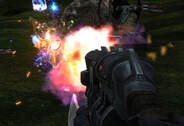
Each "core weapon" lies at an intersection. The Spiker's high rate of fire and deep magazine make it great at short range, against lots of weak units. The Needler's tracking and supercombine make it great at mid range, against single strong units. We also have "power weapons," which also have an optimal range, but work great against all compositions. This isn't a totally perfect system, and we have a couple of exceptions, but it was enough to carry us to success.
By defining these roles empirically, I could balance them empirically. I could look up my spreadsheet, and guarantee that the Spiker outdoes the Battle Rifle at close-range due to its vastly superior DPS, while falling short at long-range due to its wide error cone. I could guarantee that the Plasma Rifle maintains great general-purpose kill times against all units. I never had to guess.
By defining these roles empirically, I could balance them empirically. I could look up my spreadsheet, and guarantee that the Spiker outdoes the Battle Rifle at close-range due to its vastly superior DPS, while falling short at long-range due to its wide error cone. I could guarantee that the Plasma Rifle maintains great general-purpose kill times against all units. I never had to guess.
Tightly-Controlled Ammo Economy
You might be thinking, "this sounds great, but is it really that bad to have two weapons with the same role?" The answer is yes, because this trips against one of the primary motivators for the player to switch weapons, and therefore switch tactics: we've very carefully distributed just enough ammo around the map. Excepting the ubiquitous Plasma Pistol – whose stats are all a little worse than core weapons – the player should never be able to consistently use only one weapon without running out of ammo. At an absolute minimum, regularly alternating between two held weapons, and thus alternating between two different tactics, is necessary to not run dry.
Having two weapons fill the same role breaks this. Carrying around a role-equivalent Battle Rifle and a DMR – which could be done early-to-midway through TSC:E's development, before the latter was consigned to the special difficulty – meant that the player could always stick to the same tactic without ever running out of bullets.
I lost count of how many times a playtester (or post-release player) picked up a Battle Rifle, assumed they'd picked up God's given weapon, and immediately burned through all its ammo, trying to use it to kill every single unit. This leads to frustration, but that's the point: that's TSC:E telling you that you aren't being cool enough, and that it's time to try something more interesting.
Having two weapons fill the same role breaks this. Carrying around a role-equivalent Battle Rifle and a DMR – which could be done early-to-midway through TSC:E's development, before the latter was consigned to the special difficulty – meant that the player could always stick to the same tactic without ever running out of bullets.
I lost count of how many times a playtester (or post-release player) picked up a Battle Rifle, assumed they'd picked up God's given weapon, and immediately burned through all its ammo, trying to use it to kill every single unit. This leads to frustration, but that's the point: that's TSC:E telling you that you aren't being cool enough, and that it's time to try something more interesting.
Varied Level Design
You might now be thinking, "OK, so that's switching between two weapons, but that's hardly the full range of systems?" You'd be right. This is where the level and encounter design comes in, as the final piece of our scheme: we continually rotated the range and composition of each encounter space to ensure that, if you're trying to stick with only two guns, you're eventually going to hit a situation you can't counter.
If you've handily made it through the Brute canyon with a Needler and an Assault Rifle, your next encounter is the long-range pit, where neither of those weapons are as effective as an Auto-Carbine. Meanwhile, if you're pairing an Auto-Carbine with a Pistol, you're not going to be prepared for the claustrophobic security building. Bungie's "30 seconds of fun, over and over" is a cute catchphrase, but the reality is more sophisticated. None of our encounters exist in a vacuum; each one has a specifically considered place in the overall journey.
If you've handily made it through the Brute canyon with a Needler and an Assault Rifle, your next encounter is the long-range pit, where neither of those weapons are as effective as an Auto-Carbine. Meanwhile, if you're pairing an Auto-Carbine with a Pistol, you're not going to be prepared for the claustrophobic security building. Bungie's "30 seconds of fun, over and over" is a cute catchphrase, but the reality is more sophisticated. None of our encounters exist in a vacuum; each one has a specifically considered place in the overall journey.
“But wait, I like choosing my approach in Halo! I don’t want to play the same way each time!” We agree wholeheartedly. Our solution was not to define one optimal tactic per encounter, but a spectrum of optimal tactics, which you can pick or slide between as the situation demands. This spectrum shifts enough that you still have to eventually switch things up, but you’re also not pigeonholed into a single golden play style.
What's cool is that this isn't just reactive, asking an unprepared player to find a better tool for the job. It can also be proactive – if you've played the map before, you can plan out your route ahead of time. On Legendary, where all our knobs for pushing the player toward switching tactics are at their most demanding, this becomes outright necessary.
What's cool is that this isn't just reactive, asking an unprepared player to find a better tool for the job. It can also be proactive – if you've played the map before, you can plan out your route ahead of time. On Legendary, where all our knobs for pushing the player toward switching tactics are at their most demanding, this becomes outright necessary.
Meaningful Difficulty
In fact, it's worth noting how our beliefs clarified our approach to difficulty. This is another thing where I see most mods, and even many professional shipped games, just guessing: "I guess we should add ultra ranks." "I guess we should increase enemy damage by this much." TSC:E didn't have to guess, because we understood why we wanted difficulty levels in the first place.
The purpose of our difficulties isn't just to "be harder," or "require more skill." Both of these are easy to do, and don't mean much on their own. We could kill players in one hit from any gun. We could buff unit health so that it's impossible to kill anything
without a headshot. This is "harder," but it's not doing anything to further our goals of getting the player to interact with as many systems as possible. In fact, typically, higher difficulties in Halo convince players to interact with fewer systems! Why take the risk of doing something awesome, when it's so much safer to cling onto the gray rifle and snipe from afar?
Instead, we use difficulty levels to enforce all of our other design choices even more strongly. Careful, measured increases in unit vitality and enemy damage – we deliberately do not have any ranks beyond minor / major, outside of specific boss encounters, and we lowered the damage multiplier compared to stock Halo 1 – ensure that weapon roles are even more well defined. Killing an Elite major with a Pistol (better suited to groups of weak units) is going to take much longer, and put you at much greater risk, on Legendary than on Normal. By contrast, the Needler's single-unit kill time advantage is even more pronounced, making it even more valuable against Elites as difficulty increases.
The purpose of our difficulties isn't just to "be harder," or "require more skill." Both of these are easy to do, and don't mean much on their own. We could kill players in one hit from any gun. We could buff unit health so that it's impossible to kill anything
without a headshot. This is "harder," but it's not doing anything to further our goals of getting the player to interact with as many systems as possible. In fact, typically, higher difficulties in Halo convince players to interact with fewer systems! Why take the risk of doing something awesome, when it's so much safer to cling onto the gray rifle and snipe from afar?
Instead, we use difficulty levels to enforce all of our other design choices even more strongly. Careful, measured increases in unit vitality and enemy damage – we deliberately do not have any ranks beyond minor / major, outside of specific boss encounters, and we lowered the damage multiplier compared to stock Halo 1 – ensure that weapon roles are even more well defined. Killing an Elite major with a Pistol (better suited to groups of weak units) is going to take much longer, and put you at much greater risk, on Legendary than on Normal. By contrast, the Needler's single-unit kill time advantage is even more pronounced, making it even more valuable against Elites as difficulty increases.
In this, we once again looked at character action games. These often use difficulty not just to calibrate to the player's comfort zone, but also to engender replayability. In TSC:E, along with the stat increases, Legendary applies unique modifications to almost every encounter in the map, each specifically tailored to make switching tactics all the more necessary. The "most skilled" TSC:E player, as we see it, isn't the one with the best aim, it's the one who knows how to use every weapon in the mod to its fullest effect.
There's a lot more that went into this, but as far as the Shredder is concerned, this is getting long enough as-is. There's only one last snag.
At the end of the day, the player needs to "feel good" when they use a weapon in its intended role. Otherwise, if optimal play doesn't feel rewarding, all the design effort is wasted! About halfway through TSC:E's development, we'd learned that our clear direction, the design framework it informed, and the mathematically-sound implementation were all instrumental to making the gameplay "feel good." But, there's still a raw tactile element that no amount of balancing can solve.
To fill the role of close-range + single strong units, I'd derived T&R 2012's Brute Plasma Pistol into a small handheld plasma shotgun, whose charged shot would spray fire-goop all over the immediate area. (The proto-type lives on in TSC:E's source release, named the "Devourer.") A quick overheat made it impractical against big groups, but its kill times against strong units were great – the fire-goop's damage-over-time would burn through any vitality that the initial impact didn't. Players, however, constantly avoided the gun, never seeming to pick up on how well it could solve problems with Brutes in their face. Instead, they were just constantly annoyed at being set on fire by Jackals.
At the end of the day, the player needs to "feel good" when they use a weapon in its intended role. Otherwise, if optimal play doesn't feel rewarding, all the design effort is wasted! About halfway through TSC:E's development, we'd learned that our clear direction, the design framework it informed, and the mathematically-sound implementation were all instrumental to making the gameplay "feel good." But, there's still a raw tactile element that no amount of balancing can solve.
To fill the role of close-range + single strong units, I'd derived T&R 2012's Brute Plasma Pistol into a small handheld plasma shotgun, whose charged shot would spray fire-goop all over the immediate area. (The proto-type lives on in TSC:E's source release, named the "Devourer.") A quick overheat made it impractical against big groups, but its kill times against strong units were great – the fire-goop's damage-over-time would burn through any vitality that the initial impact didn't. Players, however, constantly avoided the gun, never seeming to pick up on how well it could solve problems with Brutes in their face. Instead, they were just constantly annoyed at being set on fire by Jackals.
This clearly wasn't working, so I went back to the drawing board. How else could I make the weapon good against single strong units? Well, players are fine with the Needler. Its base DPS isn't great; by the time you could stick some needles in a Grunt, you could've killed three of them with a Pistol. But, against beefier targets, the 7-shot supercombine shortcuts the final kill time, making it more efficient than any other weapon. What if I just took the idea of a "handheld shotgun," and made a short-range supercombine weapon?
With the math on my side, I threw together a prototype in a weekend.
With the math on my side, I threw together a prototype in a weekend.
- I didn't have to guess how strong it should be. Referring to my spreadsheet, I quickly calibrated its DPS to ensure a lethal supercombine would occur more quickly than the Spiker or Assault Rifle, the other close-range weapons, could possibly kill an Elite or Brute.
- I didn't have to guess what its rate of fire should be. While one burst can kill a Grunt instantly, I made sure that repeated bursts are still slower than mowing more of them down with the Spiker or Assault Rifle's blistering speeds.
- I didn't have to guess how many projectiles it should fire. Three projectiles, across three bursts, will reach the supercombine threshold of 7, with a little wiggle room.
- I didn't have to guess how wide the error cone should be. Our weapon range-testing map allowed me to calibrate the projectiles to go wide of a Brute as it approaches our mid-range of ~10 world units.
- I didn't have to guess how much ammo it should have. 8 bursts, or two supercombines (with wiggle room), gave it good kills-per-magazine efficiency against Elites and Brutes, but still quite a bit less against Grunts and Jackals than the Spiker, as intended.
I grabbed some Halo 3 Mauler placeholders lying around, showed the prototype to the team, and had it in for the next build. It was an instant success. Besides eventually receiving its own unique assets, and an overall mod-wide pass to autoaim, I never had to touch it again, all the way until release. The general audience liked it as much as our playtesters did. (The original internal demo video is publicly available here, if you’re curious!)
This can't be emphasized enough: I conceived, implemented, and committed the Shredder in a weekend. It was almost effortless. It wasn't a miracle of creative inspiration, it wasn't a long-wrought process of trial and error, it wasn't a lucky break. I just took the clear direction we'd established, reapplied concepts that already existed in the mod, and let the math take me the rest of the way. I never had to guess.
I guess this is the part where I conclude with actionable takeaways.
If you're in the business, or legally-not-a-business, of making Halo sandboxes, I urge you as strongly as I can without getting rude: create a spreadsheet of all your weapons and units now. Be able to know exactly how long every one of your guns takes to kill every unit, on every difficulty.
Don't "balance by feel," that's just a guess. Guesses are often wrong. Our brains are not capable of making accurate judgments about these things. "Dopamine is not specific. Success feels good, you will mistake it for good balance," is a direct quote from Jaime Griesemer, formerly of Bungie, who figured this out many years before I did. (You can watch his presentation here! Note that I don’t actually agree with all of it, and TSC:E even diverges from his other points in a few ways.)
Armed with this concrete data, I guarantee you'll find things you didn't expect. You can fix them, and see how your mod plays. Chances are, it'll feel much better. It turns out that if the numbers behind the weapons don't make any sense, players probably won't be able to make sense of them either! We learned this on T&R 2012, and it's fundamentally baked into TSC:E's gameplay.
But, even before you do that, there is no substitute for clear direction. Don't make yourself guess. What do you really want? What kinds of gameplay excite you? What doesn't? How can your mod have as much of the former, and as little of the latter, as possible? You might come up with completely different answers than I did. Balance is only a process, to be wielded for the sake of something bigger.
That’s how we made the Shredder – the same way we made the rest of the mod. We knew what we wanted, we knew why, and we had an empirical framework to carry us the rest of the way. “Balance,” and “roles,” and “difficulty,” and all those other hot topics were simply tools to get us there. When you know what you want, you never have to guess, and when you never have to guess, you can only ever be right.
If you're in the business, or legally-not-a-business, of making Halo sandboxes, I urge you as strongly as I can without getting rude: create a spreadsheet of all your weapons and units now. Be able to know exactly how long every one of your guns takes to kill every unit, on every difficulty.
Don't "balance by feel," that's just a guess. Guesses are often wrong. Our brains are not capable of making accurate judgments about these things. "Dopamine is not specific. Success feels good, you will mistake it for good balance," is a direct quote from Jaime Griesemer, formerly of Bungie, who figured this out many years before I did. (You can watch his presentation here! Note that I don’t actually agree with all of it, and TSC:E even diverges from his other points in a few ways.)
Armed with this concrete data, I guarantee you'll find things you didn't expect. You can fix them, and see how your mod plays. Chances are, it'll feel much better. It turns out that if the numbers behind the weapons don't make any sense, players probably won't be able to make sense of them either! We learned this on T&R 2012, and it's fundamentally baked into TSC:E's gameplay.
But, even before you do that, there is no substitute for clear direction. Don't make yourself guess. What do you really want? What kinds of gameplay excite you? What doesn't? How can your mod have as much of the former, and as little of the latter, as possible? You might come up with completely different answers than I did. Balance is only a process, to be wielded for the sake of something bigger.
That’s how we made the Shredder – the same way we made the rest of the mod. We knew what we wanted, we knew why, and we had an empirical framework to carry us the rest of the way. “Balance,” and “roles,” and “difficulty,” and all those other hot topics were simply tools to get us there. When you know what you want, you never have to guess, and when you never have to guess, you can only ever be right.

